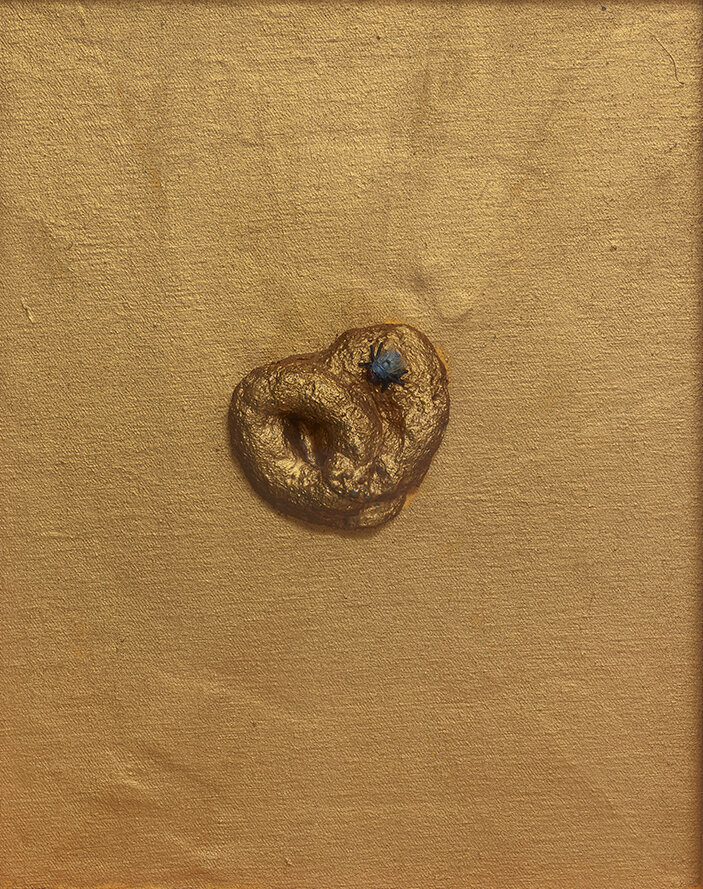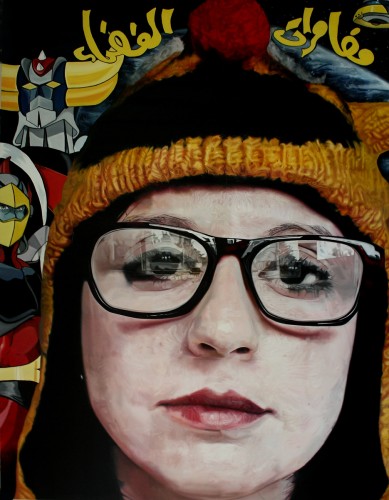Born in Beirut, Lebanon on May 25th, 1983, Inaya Fanis Hodeib spent her formative years navigating the complexities of a city marked by the tail end of the Lebanese Civil war. Despite challenges,...



-Front.jpg)
-Front.jpg)
Born in Beirut, Lebanon on May 25th, 1983, Inaya Fanis Hodeib spent her formative years navigating the complexities of a city marked by the tail end of the Lebanese Civil war. Despite challenges,...
Born in Beirut, Lebanon on May 25th, 1983, Inaya Fanis Hodeib spent her formative years navigating the complexities of a city marked by the tail end of the Lebanese Civil war. Despite challenges, her artistic inclinations emerged early, setting her on a path of creative exploration. Hodeib initially pursued a degree in English Literature, but her passion for fine arts ultimately drew her to the Lebanese University's Institute of Fine Arts1.
Immersing herself in the world of fine arts, Hodeib dedicated relentless hours to honing her craft, delving into the intricate techniques and methodologies of painting and drawing. Under the guidance of mentors like the artists and professors Dr. Fouad Jawhar and Dr. Mohammad El Rawas, she explored the nuances of color theory and printmaking, enriching her artistic repertoire. Hodeib graduated with honors from the Lebanese University's Fine Arts Institute in 2006, marking the beginning of her artistic career.
Another influential figure in shaping her artistic outlook was the Lebanese-American artist and critic Helen el Khal. In 2008, while employed at the Verdun Safana Art Gallery, Hodeib had the opportunity to curate el Khal's final retrospective before her passing. Over the course of almost two months, they developed a close bond, spending extended periods together, predominantly in el Khal’s studio. During this time, el Khal not only shared her blending technique with Hodeib, but also instilled in her a deeper understanding of what it meant to be a female artist and how to navigate life's adversities, drawing from her own extensive personal struggles.
In 2008, Hodeib relocated to the Netherlands and established her studio, where she continued to experiment with her work. Drawing inspiration from her Lebanese roots and her experiences in her adopted homeland, Hodeib’s work transcends conventional boundaries, blending elements of hyperrealism with pop art sensibilities. Her preferred medium, oil on canvas, serves as a vessel for her introspective exploration and emotive expression. Her oeuvre reflects a profound appreciation for the intricacies of human emotion and societal dynamics. From her early fascination with Dutch artist Peter Paul Rubens, to her deep dive into medieval studies and art history, her work is imbued with layers of meaning and historical context. Her exploration of negative spaces and composition, influenced by the tutelage of the textile engineer and artist Edgard Mazigi, remains integral to her artistic process.
Hodeib explores recurring themes and subjects, including portraits, dogs, and nostalgic items like the ubiquitous Tetra and Nido milk brand cans commonly known to Lebanese. She considers each piece to be an auto-portrait, representing her inner thoughts and emotions. The Canine series, in particular, which presents several paintings of angry dogs and wolves, addresses societal issues. Condensed in maxims such as "dog eat dog"2 and "survival of the fittest", the series reflects the artist's personal struggles with social anxiety and frustration. These pieces serve as a form of self-expression during times of feeling misunderstood or trapped. Despite their personal nature, the series resonates with many viewers who appreciate its honesty and emotional depth. Through her art, Hodeib attempts to bridge the gap between internal feelings and external perceptions.
Among her notable series is the collection of 24 watercolors on paper3, housed at the Ramzi and Saeda Dalloul Art Foundation, depicting vintage Lebanese products and their cultural significance. This series, born out of personal loss and the challenges posed by the COVID-19 pandemic, serves as a tender reflection of Hodeib’s emotional landscape. One of her iconic artworks in the series features a realistic depiction of a used Nestlé Nido full cream powdered milk can. The can, rendered in vibrant yellows and reds, is repurposed as a planter with green chili peppers growing out of it. Arabic text prominently appears on the label, emphasizing the cultural or regional context of the piece. The background is minimalistic, focusing attention on the can and its contents. The painting showcases Hodeib's skill in detailed, lifelike watercolor work while also capturing the essence of nostalgia and collective memory.
The watercolor series serves as a way of dealing with the her father’s passing while giving meticulous attention to detail as her commitment to authenticity. In doing so, she invites viewers to reconnect with the simplicity of the past. However, most of Hodeib’s work is fueled by the desire to preserve things and people she loves in an attempt to make them immortal. She describes herself as extremely sensitive to loss, no matter how small the loss may be. Moreover, in her watercolor series, another condition she placed for herself was to draw or paint everything from pure memory. Sometimes Hodeib resorted to looking up visual references and images to remember a color on a product or the type of lettering, but she did not use any references to copy. Therefore, a lot of the pieces have inaccuracies in shape, or are missing a word, or design element. It was crucial for Hodeib to leave things exactly as her memory saw them, as it gave the series a more organic touch matching her intention for its creation.
Currently, Hodeib is immersed in a series of portraits linked to her ongoing project, Stories from B Town4, which aims to document the essence of Beirut through recognizable faces and events. With each painting serving as a narrative puzzle, she invites viewers to partake in the storytelling process, weaving together threads of memory and imagination. Hodeib remains steadfast in her commitment to preserving the fleeting moments of life through art.
Hodeib’s artistic journey reflects the trials of a war-ridden environment. Her work serves as a means to document and preserve the imperfect intricacies of a distant memory. As she navigates the complexities of identity, memory, and human connection, the artist creates a means to express both her personal as well as a collective human experience. Today, Hodeib continues to reside and work in her studio in the Netherlands.
Edited by Elsie Labban
1 “Inaya Fanis Hodeib.” n.d. Barjeel Art Foundation. Accessed April 26, 2024. www.barjeelartfoundati.org
2 Cambridge Dictionary. 2022. “Dog-Eat-Dog.” @CambridgeWords. May 11, 2022. www.dictionary.cambridge.org
3 “Untitled by INAYA FANIS-HODEIB.” n.d. Dalloul Art Foundation. Accessed April 29, 2024. www.dafbeirut.org
4 2024. Barjeelartfoundation.org. 2024.

Sources
Interview between Christine Labban with Inaya Fanis Hodeib.
2024. Barjeelartfoundation.org. 2024. https://www.barjeelartfoundation.org/wp-content/
“Inaya Fanis Hodeib.” n.d. Barjeel Art Foundation. Accessed April 26, 2024. www.barjeelartfoundation.org/artist/.
“INAYA FANIS-HODEIB - Artists.” n.d. Dalloul Art Foundation. Accessed April 29, 2024. www.dafbeirut.org/en/
Selected Group Exhibitions
Hope in an Age of Dystopia, Dalloul Art Foundation, Beirut, Lebanon
Arabic Music and Dance Event, Gallery Wies Willemsen, Amsterdam, Netherlands
The Eye Film Institute, Amsterdam, Netherlands
Stedelijk Museum, Amsterdam, Netherlands
Anniversary Exhibition, Gallery Ramfjord, Oslo, Norway
Gallery Ramfjord, Oslo, Norway
Exposure 2013: 5thAnnual Exhibition of Beirut Art Center (BAC), Beirut, Lebanon
Ayyam Gallery, Beirut, Lebanon
The Young Collectors Auction, Ayyam Gallery, Dubai, United Arab Emirates
The Rainbow Experience, Cape Town City Center, Cape town, South Africa
Warwick Gallery, Warwick, New York, United States of America
Ostra Gallery, Stockholm, Sweden
Curational Projects
SOUK!, Co-curator of the Arabic music and dance event at the Concertgebouw, in collaboration with Wies Willemsen Gallery, Amsterdam, Netherlands
Collections
Ramzi and Saeda Dalloul Art Foundation (DAF), Beirut, Lebanon
Barjeel Art Foundation, Sharjah, United Arab Emirates
Mokbel Art Collection, Dubai, United Arab Emirates
Mana Contemporary Art Center, New Jersey, United States of America
Join us in our endless discovery of modern and contemporary Arab art
Get updates from DAF
Follow Artists
Save your favourite Artworks
Share your perspectives on Artworks
Be part of our community
It's Free!
We value your privacy
TermsCookiesPrivacy Policies
Get updates from DAF
Follow Artists
Save your favourite Artworks
Share your perspectives on Artworks
Be part of our community
It's Free!
We value your privacy
TermsCookiesPrivacy Policies
Get updates from DAF
Follow Artists
Save your favourite Artworks
Share your perspectives on Artworks
Be part of our community
It's Free!
We value your privacy
TermsCookiesPrivacy Policies
If you have entered your email to become a member of the Dalloul Art Foundation, please click the button below to confirm your email and agree to our Terms, Cookie & Privacy policies.
We value your privacy, see how
Get updates from DAF
Follow Artists
Save your favourite Artworks
Share your perspectives on Artworks
Be part of our community
It's Free!
We value your privacy
TermsCookiesPrivacy Policies
-Front.jpg)
-Front.jpg)
-Front.jpg)
-Front.jpg)
-Front.jpg)
-Front.jpg)
-Front.jpg)
-Front.jpg)
-Front.jpg)
-Front.jpg)
-Front.jpg)
-Front.jpg)
-Front.jpg)
-Front.jpg)